If you’re looking for a group of plants that can easily add texture and tropical touches to your garden or living spaces, look no further than Australian palms. I love palm trees for their gorgeously textured fronds and their lively presence in gardens with many species being perfectly suited to indoor cultivation as well.
My Kentia Palm has been a long-time favourite in the lounge. There is a wide variety of attractive palm species to choose from in Australia. Whether it’s our Australian native palms or one of the many stunning introduced species on offer, each has its unique features, characteristics, and growing requirements.
So, in today’s article, I will be highlighting 20 fantastic Australian palms worth considering, in the hopes I can help you find the perfect pick for your gardening needs.
More...
Brief Introduction to Australian Palms
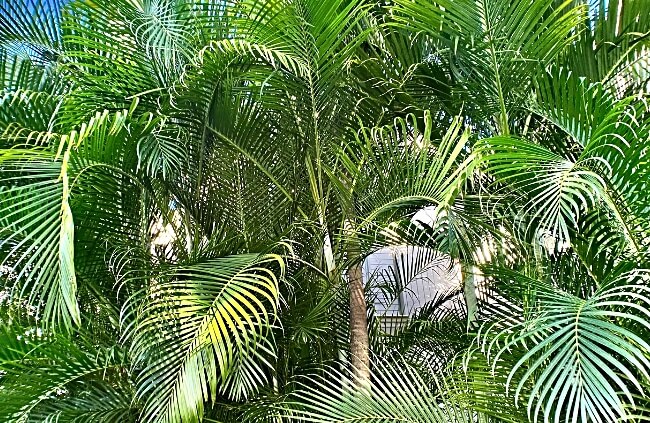
Palm trees form a part of the Arecaceae family of perennial flowering plants with over 25,000 species recognised globally and over 50 Australian native palms. Palm trees are characterised by their tall and slender unbranched stems and their large evergreen leaves, also known as fronds.
The wonderfully textured fronds crown the tops of the branches, creating the sense of a tropical paradise without compromising on the durability and functionality of the plants.
There are two types of palm trees, pinnate palms, and palmate palms.
- Pinnate palms have feathery fronds with leaflets arranged on either side of the central midrib.
- Palmate palms have large, fan-shaped fronds with leaflets attached to a central common point on the stems.
20 Best Australian Palms to Grow
1. Foxtail Palm – Wodyetia bifurcata
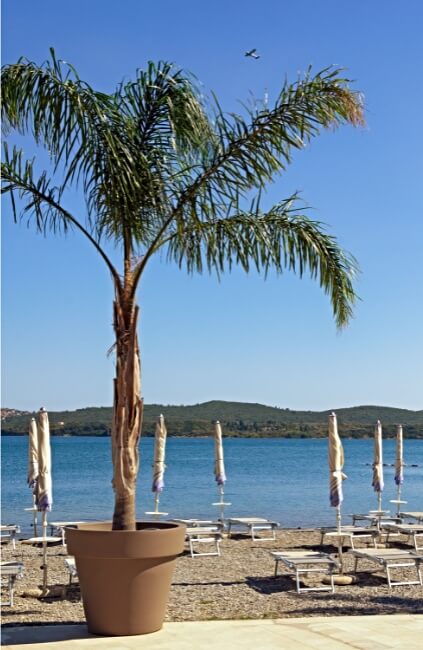
Native to the Queensland coast, the Foxtail palm is one of the most cultivated Australian native palms, featuring thick and fluffy lime-green fronds that gently arch with a smooth and attractive trunk to boot. It is suited for tropical to temperate climates.
- Size: 10 to 15 metres tall, up to 5 metres wide
- Location: Outdoors
- Foxtail Palm Growing Guide
2. Alexander Palm – Archontophoenix alexandrae
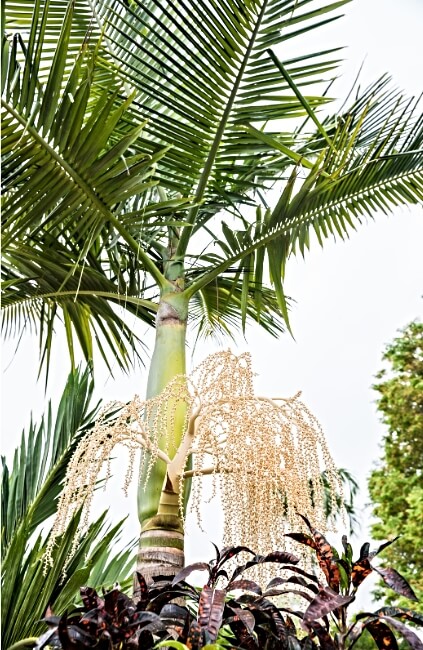
With its smooth slender trunk and gracefully arching fronds, this native palm tree can offer excellent sophistication to your landscape design. It produces delicate white flowers and bright red fruits, further enhancing its showiness in gardens. Suits subtropical and coastal climates.
- Size: 10 to 20 metres tall, 2 to 4 metres wide
- Location: Outdoors in the garden bed or containers
- Alexander Palm Growing Guide
3. Cabbage Tree Palm – Livistona australis
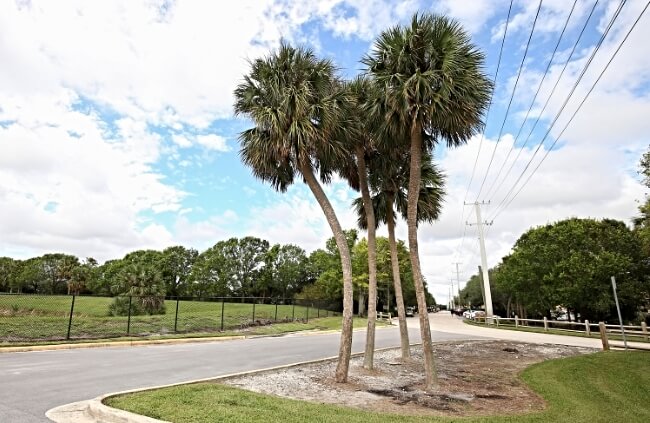
These hardy but slow-growing Australian palms can tolerate many weather conditions, sporting tall and slender grey trunks and creamy-white blooms. This species thrives in partly shaded positions but can tolerate full sun in cooler climates.
- Size: Up to 25 metres tall and 10 metres wide
- Location: Outdoors
4. Golden Cane Palm – Dypsis lutescens
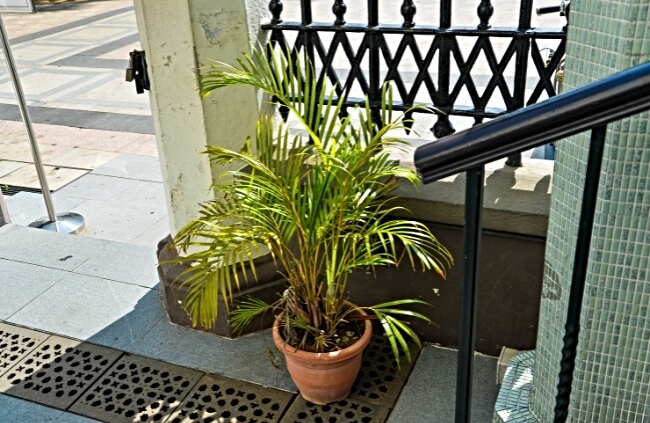
One of the most popular and useful landscaping plants in its family, the Golden cane palm is the perfect pick for bringing that tropical feel to your garden or home.
It produces dense foliage and is prized for its golden-green leaves and blonde canes. Makes for a great container garden species.
- Size: 4 to 6 metres tall, 2 to 3 metres wide
- Location: Indoors and outdoors
- Golden Cane Palm Growing Guide
5. Kentia Palm – Howea forsteriana
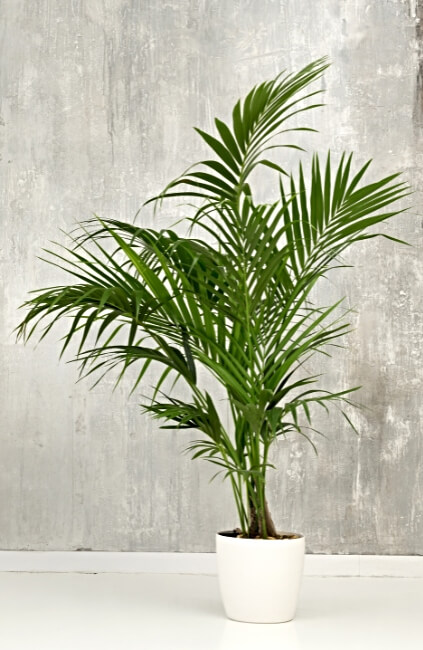
An elegant palm that grows well in containers and is a global favourite indoors. It is a medium-sized member of the family, with large fronds, an attractive slender trunk, and orange to red fruits.
- Size: Up to 15 metres tall and 5 metres wide (smaller indoors)
- Location: Indoor and outdoor
- Kentia Palm Growing Guide
6. Australian Fan Palm – Licuala ramsayi
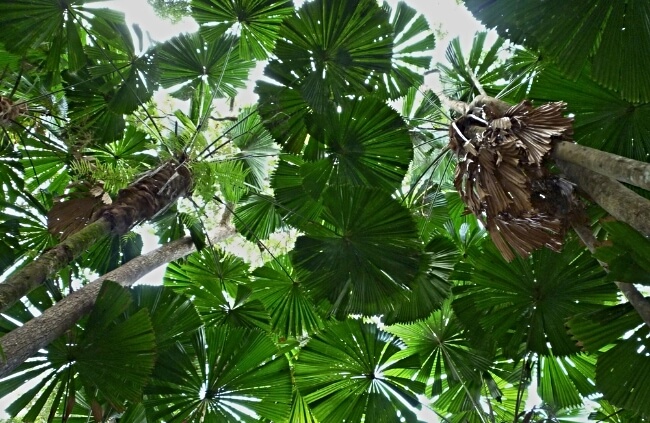
A spectacular native rainforest species that performs well in garden beds and containers. It is prized for its near-circular fronds that have distinctive fan-shaped leaves that maintain an attractive upright habit.
It needs lots of shade while young and looks fantastic planted alongside other palms.


Get Your Free Guide:
Master Growing Australian Natives eBook
A Must Have Complete Guide for Every Australian Garden
Get Your Free Guide:
Master Growing Australian Natives eBook
A Must Have Complete Guide for Every Australian Garden
- Size: 10 to 20 metres tall, up to 5 metres wide
- Location: Outdoors
7. Ponytail Palm – Beaucarnea recurvata
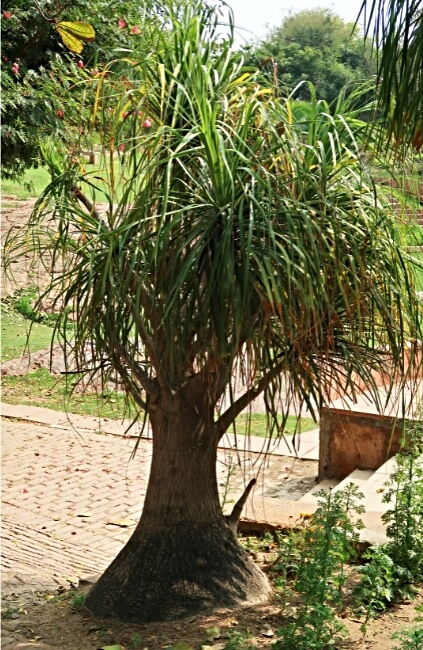
While not a true palm, this introduced species makes for an excellent low-maintenance palm-like addition to warmer gardens. It grows from a lignotuber and has long, tapered sword-shaped leaves that are borne on a dense and rounded crown.
- Size: 2 to 10 metres tall, 1.5 to 3 metres wide
- Location: Indoor and outdoor
- Ponytail Palm Growing Guide
8. Bangalow Palm – Archontophoenix cunninghamiana

Perhaps one of our most popular Australian native palms for home landscaping, the Bangalow palm, also known as the king palm, is a gorgeous fast-growing specimen that looks like the Alexander palm but has a thinner trunk and greener foliage. A great palm for attractive birds.
- Size: Up to 20 metres tall and 6 metres wide
- Location: Outdoors
- Bangalow Palm Growing Guide
9. Bamboo Palm – Chamaedorea seifrizii
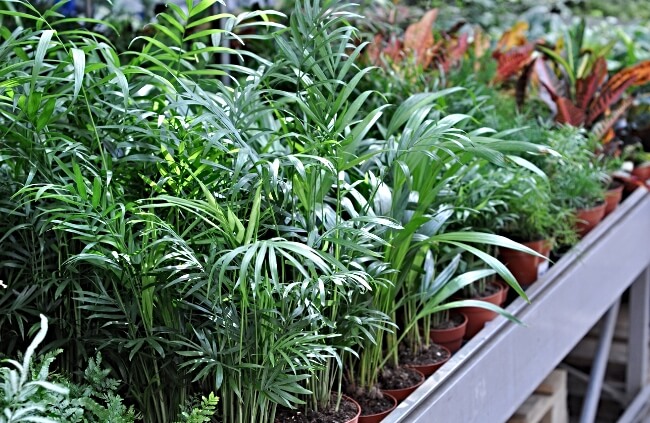
A globally adored species that is grown for its excellent utility indoors. It features lacy fronds that adorn tall multi-trunked bamboo-like stems, all boosted by the plant's stunning upright growing habit.
- Size: Up to 3 metres tall and 2 metres wide indoors
- Location: Indoor and outdoor
10. Coconut Palm – Cocos nucifera
Another one of our iconic Australian palms. As its name suggests, this tropical species produces big coconut-like fruits and sports large pinnate fronds, a grey bark, and cream-coloured flowers. Great for coastal gardening!
- Size: 25 to 30 metres tall, 10 to 15 metres wide
- Location: Outdoors
11. Black Palm – Normanbya normanbyi
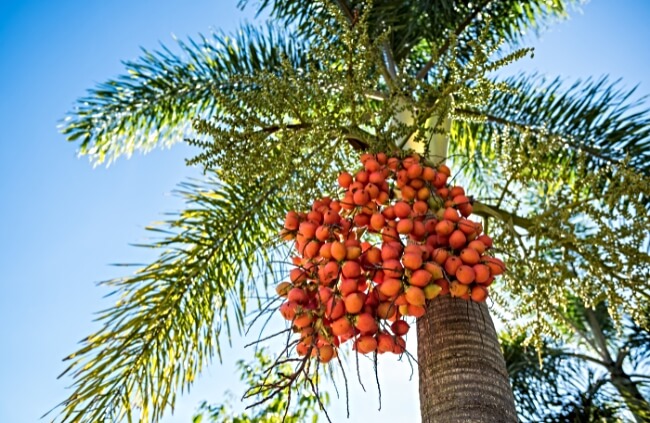
Native to North Queensland rainforests, this plant is tall, handsome, and bountiful. Its trunk is smooth and light grey, turning blacker as it ages. It sports large fluffy fronds, colourful fruits, and white blooms. It thrives in humid environments.
- Size: Up to 20 metres tall and 10 metres wide
- Location: Outdoors
12. Australian Dwarf Fan Palm – Livistona muelleri

Source: PalmPedia
These Australian native palms are smaller-growing, perfect for gardens that don’t have the space for large trees. It is an ordinary but ornamental species with large palmate fronds that grow in a lovely fanning cluster at the top of the trunk.
- Size: Up to 4 metres tall and 2 metres wide
- Location: Outdoors
13. Lady Palm – Rhapis excelsa

While being a slow-growing introduced species, it is perfectly suited to indoor cultivation, sporting a lovely clumping habit with stems that develop a bamboo-like pattern and form. It is an elegant and graceful species that needs some shelter from strong cold winds.
- Size: 2 to 4 metres tall, 1 to 2 metres wide
- Location: Indoor and outdoor
- Lady Palm Growing Guide
14. Sago Palm – Cycas revoluta
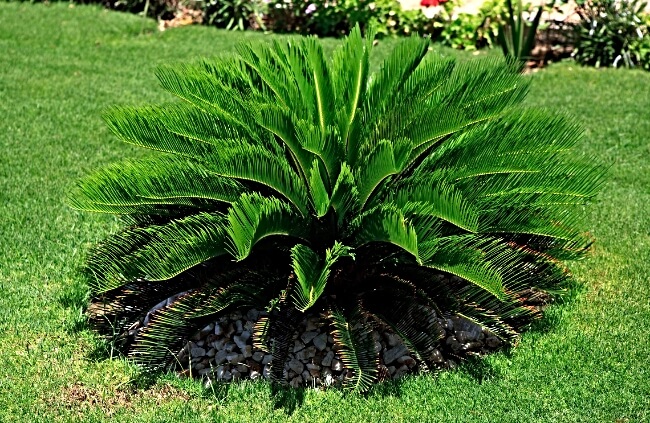
A popular houseplant globally, the Sago palm is a coniferous species that produces large pinnate fronds that form in a rounded, upright habit, perfect for filling out tough spots in the garden or your home. It can be distinguished by its thick fibrous trunk.
- Size: Up to 3 metres tall and wide
- Location: Indoor and outdoor
- Sago Palm Growing Guide
15. Umbrella Palm – Hedyscepe canterburyana

Source: Plants of the World Online
These Australian palms are native to Lord Howe Island and feature a silvery crown stem with compact dark-green fronds that grow in often sporadic and exciting ways. Its flowers are yellow with deep-red fruits.
- Size: Up to 10 metres tall and 5 metres wide
- Location: Outdoors
16. European Fan Palm – Chamaerops humilis

An excellent pick for cooler climates since this hardy species can tolerate frosts and winds. It is notorious for its fan-shaped triangular leaves that are slightly variegated in hues of silver and green. Makes for a useful feature plant in gardens.
- Size: 3 to 6 metres tall and wide
- Location: Outdoors
17. Chinese Windmill Palm – Trachycarpus fortunei
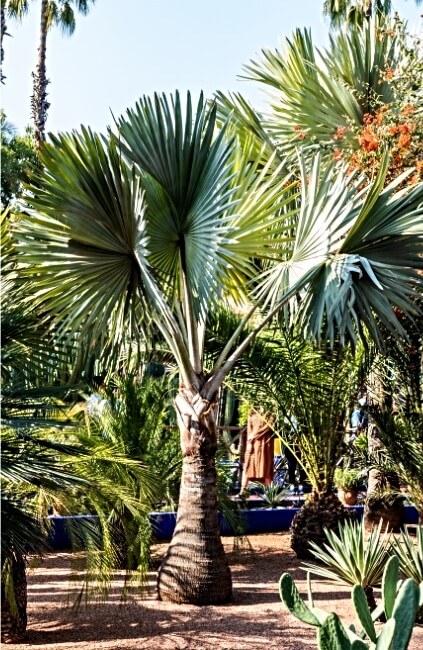
These stunning introduced Australian palms are perfect for landscaping in temperate climates, featuring an elegant shape with graceful fronds, able to create beautiful silhouettes in the garden or courtyard. Needs protection from strong winds when young.
- Size: 5 to 7 metres tall, 3 to 4 metres wide
- Location: Outdoors
18. Chilean Wine Palm – Jubaea chilensis
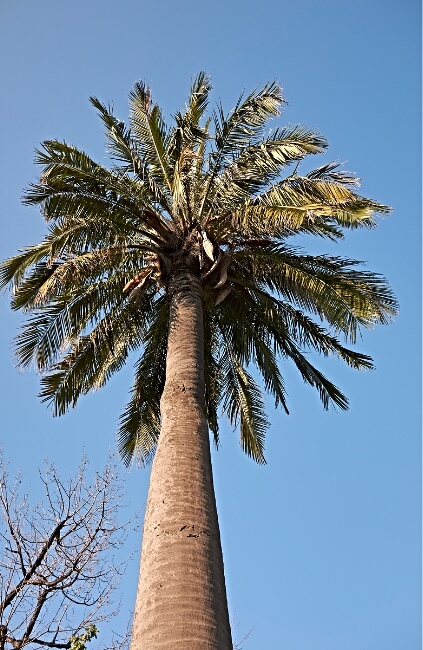
Native to Chile, this palm is one of the most southerly grown in the world. It is a hardy and striking species that produces massive pinnate fronds that form a rounded canopy, all elevated by the plant’s larger-than-life trunk.
- Size: 15 to 25 metres tall, 6 to 8 metres wide
- Location: Indoor and outdoor
19. Carpentaria Palm – Carpentaria acuminata
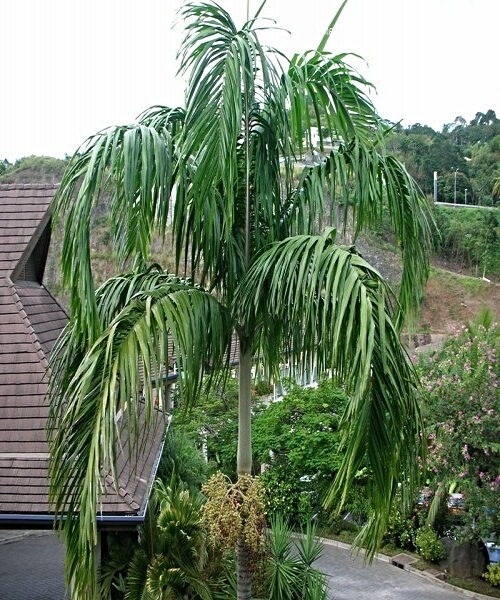
Source: Wahat Al Sahraa Nursery
A sole species in its genus, this palm is one of my favourite Australian native palms thanks to its elegant and tidy form. The trunk is greyish green with lime-green fronds that make up the attractive canopy.
- Size: Up to 15 metres tall and 3 metres wide
- Location: Outdoors
20. Parlour Palm – Chamaedorea elegans
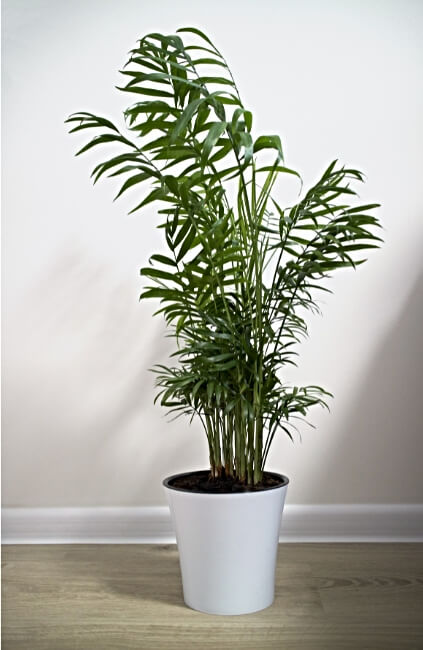
A gorgeous introduced palm that is perfect for indoors! It is considered a slow-growing dwarf species that forms large clusters of slender stems and green pinnate foliage that droops elegantly. It needs protection from strong winds and frost.
- Size: 2 to 4 metres tall and wide
- Location: Indoor and outdoor
- Parlour Palm Growing Guide
Benefits of Growing Introduced and Australian Native Palms
- Palm trees are attractive with many suited to both indoor and outdoor cultivation.
- They are hardy and long-living plants.
- There is a variety of species offering different textures, sizes, applications, and colours.
- Australian native palms thrive in our endemic climates.
- Palms can add unparalleled tropical textures to both indoor and outdoor spaces.
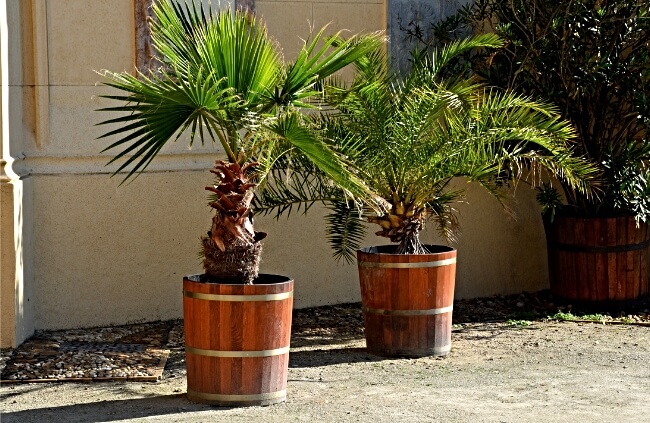
Tips on Growing and Caring for Australian Palms
I believe one of the key factors when growing healthy palms is to ensure they have the right soil composition, lighting, and space to grow. While they are generally low-maintenance plants, some TLC can also certainly go a long way, especially during the developmental years.
Here are some quick tips for gardening with palm trees:
- Palms prefer moist, enriched soil that is well-draining but can tolerate most garden soils with the addition of some compost and organic matter.
- Outdoors palm trees love full sun to part shade with at least 6 hours of bright daily light. Some may need shade while young.
- Indoor palms thrive with plenty of bright indirect light.
- Indoor palms typically grow well in quality potting soil that drains effectively.
- Dwarf palms may need to be overwintered or covered with a frost cover in cooler climates.
- A soil pH of between 6 and 7 is suitable for most palm species.
- Palms require regular water, fertiliser, and pruning, especially when young.
In the end, I recommend choosing a species that is well suited to your area and conditions and then trying to do specific research on how to care for that species as growing requirements can differ between every palm.
Australian Palms Frequently Asked Questions

What is the fastest growing palm in Australia?
The Bangalow palm is endemic to the central-eastern coast of Australia and is considered one of our hardiest and fastest growing palm species, able to grow up to 1 metre every year.
How long do palm trees live in Australia?
On average, most introduced and Australian native palms live for around 100 years with some pioneer species able to live for over 500 years! They are global garden favourites that add long-lived textural appeal.
What is the easiest palm to grow?
The Golden cane palm and Kentia palm are particularly forgiving indoors but generally speaking, most species of palm are relatively easy to grow and care for once established.
How often should you water a palm tree?
Young palms should be watered every day during their first week to help settle them. Thereafter, 2 to 3 times a week should be plenty for more established palms. Water when the top 2 to 4 centimetres of soil has dried.
What fertiliser is best for palms?
Palm trees respond well to being fertilised 3 to 4 times a year. A slow-release organic fertiliser or a blood and bone meal can work great.
What soil is best for palm trees?
Palms thrive in light, well-drained soils. For gardens, sandy loam soil is often best whereas for indoor palms, a premium potting mix would be ideal.
Take Your Garden and Home Aesthetics to New Heights with Australian Palms
So, there you have it, 20 stunning introduced and Australian native palms worth considering for both indoor and outdoor applications. The feathery fronds can add lovely textured shade to gardens or tropical touches to living spaces, easily elevating the aesthetic appeal of any surrounding environment.
I hope you have a better idea of which of these Australian palms are right for your needs and I wish you many happy years of gardening with them!
Published on January 17, 2024 by Gary Clarke
Last Updated on September 20, 2024




